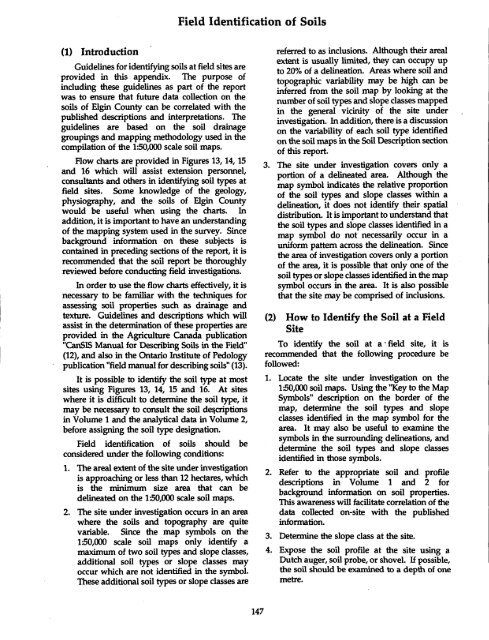The Soils of Elgin County - Agriculture and Agri-Food Canada
The Soils of Elgin County - Agriculture and Agri-Food Canada
The Soils of Elgin County - Agriculture and Agri-Food Canada
- No tags were found...
Create successful ePaper yourself
Turn your PDF publications into a flip-book with our unique Google optimized e-Paper software.
Field Identification <strong>of</strong> <strong>Soils</strong>(1) IntroductionGuidelines for identifying soils at field sites areprovided in this appendix . <strong>The</strong> purpose <strong>of</strong>including these guidelines as part <strong>of</strong> the reportwas to ensure that future data collection on thesoils <strong>of</strong> <strong>Elgin</strong> <strong>County</strong> can be correlated with thepublished descriptions <strong>and</strong> interpretations . <strong>The</strong>guidelines are based on the soil drainagegroupings <strong>and</strong> mapping methodology used in thecompilation <strong>of</strong> the 1:50,000 scale soil maps .Flow charts are provided in Figures 13, 14, 15<strong>and</strong> 16 which will assist extension personnel,consultants <strong>and</strong> others in identifying soil types atfield sites. Some knowledge <strong>of</strong> the geology,physiography, <strong>and</strong> the soils <strong>of</strong> <strong>Elgin</strong> <strong>County</strong>would be useful when using the charts. Inaddition, it is important to have an underst<strong>and</strong>ing<strong>of</strong> the mapping system used in the survey . Sincebackground information on these subjects iscontained in preceding sections <strong>of</strong> the report, it isrecommended that the soil report be thoroughlyreviewed before conducting field investigations .In order to use the flow charts effectively, it isnecessary to be familiar with the techniques forassessing soil properties such as drainage <strong>and</strong>texture. Guidelines <strong>and</strong> descriptions which willassist in the determination <strong>of</strong> these properties areprovided in the <strong><strong>Agri</strong>culture</strong> <strong>Canada</strong> publication"CanSIS Manual for Describing <strong>Soils</strong> in the Field"(12), <strong>and</strong> also in the Ontario Institute <strong>of</strong> Pedologypublication "field manual for describing soils" (13) .It is possible to identify the soil type at mostsites using Figures 13, 14, 15 <strong>and</strong> 16 . At siteswhere it is difficult to determine the soil type, itmay be necessary to consult the soil descriptionsin Volume 1 <strong>and</strong> the analytical data in Volume 2,before assigning the soil type designation.Field identification <strong>of</strong> soils should beconsidered under the following conditions:1 . <strong>The</strong> areal extent <strong>of</strong> the site under investigationis approaching or less than 12 hectares, whichis the minimum size area that can bedelineated on the 1:50,000 scale soil maps .2 . <strong>The</strong> site under investigation occurs in an areawhere the soils <strong>and</strong> topography are quitevariable . Since the map symbols on the150,000 scale soil maps only identify amaximum <strong>of</strong> two soil types <strong>and</strong> slope classes,additional soil types or slope classes mayoccur which are not identified in the symbol.<strong>The</strong>se additional soil types or slope classes arereferred to as inclusions. Although their arealextent is usually limited, they can occupy upto 20% <strong>of</strong> a delineation. Areas where soil <strong>and</strong>topographic variability may be high can beinferred from the soil map by looking at thenumber <strong>of</strong> soil types <strong>and</strong> slope classes mappedin the general vicinity <strong>of</strong> the site underinvestigation . In addition, there is a discussionon the variability <strong>of</strong> each soil type identifiedon the soil maps in the Soil Description section<strong>of</strong> this report.3. <strong>The</strong> site under investigation covers only aportion <strong>of</strong> a delineated area . Although themap symbol indicates the relative proportion<strong>of</strong> the soil types <strong>and</strong> slope classes within adelineation, it does not identify their spatialdistribution . It is important to underst<strong>and</strong> thatthe soil types <strong>and</strong> slope classes identified in amap symbol do not necessarily occur in auniform pattern across the delineation . Sincethe area <strong>of</strong> investigation covers only a portion<strong>of</strong> the area, it is possible that only one <strong>of</strong> thesoil types or slope classes identified in the mapsymbol occurs in the area . It is also possiblethat the site may be comprised <strong>of</strong> inclusions.(2) How to Identify the Soil at a FieldSiteTo identify the soil at a - field site, it isrecommended that the following procedure befollowed :1 . Locate the site under investigation on the1:50,000 soil maps . Using the "Key to the MapSymbols" description on the border <strong>of</strong> themap, determine the soil types <strong>and</strong> slopeclasses identified in the map symbol for thearea. It may also be useful to examine thesymbols in the surrounding delineatins, <strong>and</strong>determine the soil types <strong>and</strong> slope classesidentified in those symbols .2. Refer to the appropriate soil <strong>and</strong> pr<strong>of</strong>iledescriptions in Volume 1 <strong>and</strong> 2 forbackground information on soil properties .This awareness will facilitate correlation <strong>of</strong> thedata collected on-site with the publishedinformation.3 . Determine the slope class at the site.4. Expose the soil pr<strong>of</strong>ile at the site using aDutch auger, soil probe, or shovel . If possible,the soil should be examined to a depth <strong>of</strong> onemetre .147
















